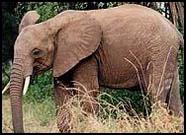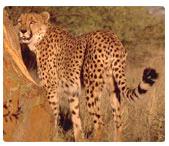
Africa
Africa is a very hot climate continent,
with landscapes ranging from wide deserts to
small jungles. This is one of the
more popular continents for endangered species, there
are many poachers. On this continent they
are many animals from huge elephants to
small desert snakes. Predatorial cheetahs ato antelope prey.
This continent is a great wasteland
full of exotic animals.

Elephants
Elephants roam the whole of the continent instead of being dotted around the place. A fully grown adult male african savannah elephant is the largest land mammal on earth. It can grow upto 10 feet tall at the shoulder and has the wieght of 12,000 pounds. An african forest elephant is only 10,000 pounds at the most. The latin name for an elephant is "pachyderm" meaning "thick-skinned". The savannah elephants tusks are curved whereas the jungle elephant has small and straight tusks. When an elephant rolls around in the mud it acts as a sunblock. In the height of summer the mud they roll in cools them down and acts as an extra layer of cover against the sun's UV rays and insects.

Forest elephant
When a male is 14 years old, he leaves the herd. They then usually wander alone or join other male elephants in "bachelor herds" and they only every join females at mating times. The motherprovides milk for the calves. A newborn calf is usually aroun 250 pounds! The other females in the herd without a calf will come to help the mother to care for the calf. These are also known as "allomothers" who are learning to care for a calf. Males usually leave the herd earlier than females. Some males have been seen wandering outside the family herd from about the age of six years old. A calf learns by watching and copying others. It will try and grab food and solid objects with its trunk at about four months of age. But a full grown male elephant has 40,000 muscles inside the trunk alone that give the elephant a huge, long snout.
Cheetah
The cheetah is the fastest land animal in the world, reaching speeds of upto 70 miles per hour in short bursts. The cheetah has longer legs than other cats helping its speed and agility. Although they are fast animals, they can only run for about a minute full speed perhaps less. These remarkable creatures have weak jaw muscles and small teeth, this makes up for the amazing speed. When a cheetah makes a kill it feeds, but it cannot defend itself from a larger predator if attacked. Likewise it cannot protect it's cub if opposed.

Cheetah in savannah
Cubs must learn how to stalk their prey and catch them at a precise, well-timed moment. This is usually known as the "chase-trip-bite". Cheetahs must creep within just a few hundred feet of their target, then, burst into a speed of nearly 60 miles per hour. Then the cheetah uses the front foot to strike the prey, winding it. Also the cheetah uses it's back foot to trip it. Then the cheetah grabs his prey by the throat, killing it. This is how a cheetah does the "chase-trip-bite" and how a cheetah kills it's prey.
Even more animals to come, watch this space
Navigation


